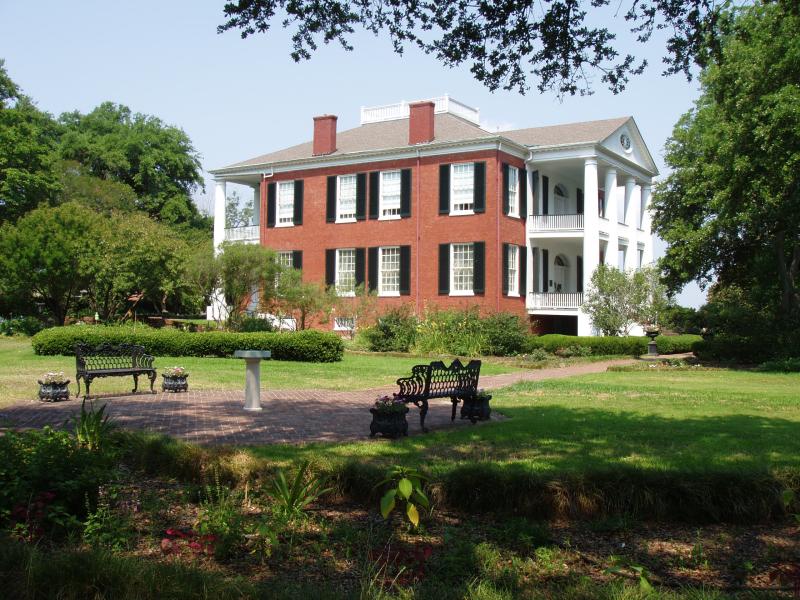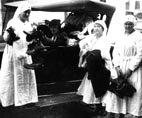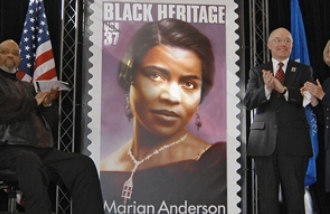Throughout the history of DAR Historic Preservation has always been one of the main focuses of the mission of the organization. DAR members participate is a wide variety of Historic Preservation projects as it is crucial to saving our history for future generations.
Historic Preservation
Louisiana Purchase
The Arkansas Daughters may hold the distinction of one of the most unusual locations for a DAR marker. Following the discovery in 1921 of the slash marks on gum trees made by the original surveyors of the Louisiana Purchase in 1815, the L’Anguille Chapter in Marianna, Arkansas, seized the rediscovery as a historical cause. In 1926, they met at a temporarily dry site to dedicate this stone monument erected at the Louisiana Purchase Initial Survey Point. It is from this point that all land in the Louisiana Purchase, 83,000 miles of wilderness, was mapped. A survey of the new land began in 1815 in East Arkansas. The 1921 discovery and subsequent marking focused attention on the site, located in a swamp in the Little Cypress Creek watershed at the corner of Lee, Phillips and Monroe Counties, that had gone unheralded for more than a century. The DAR had also obtained deeds from landowners dedicating enough land for a small park at the site. The Arkansas General Assembly passed legislation in 1961 setting aside the area that ultimately became the Louisiana Purchase Historic State Park, where visitors can walk along a boardwalk through the swamp to see the stone and experience the sites and sounds of the wilderness, as did the original surveyors. Photo courtesy of Arkansas Department of Parks and Tourism
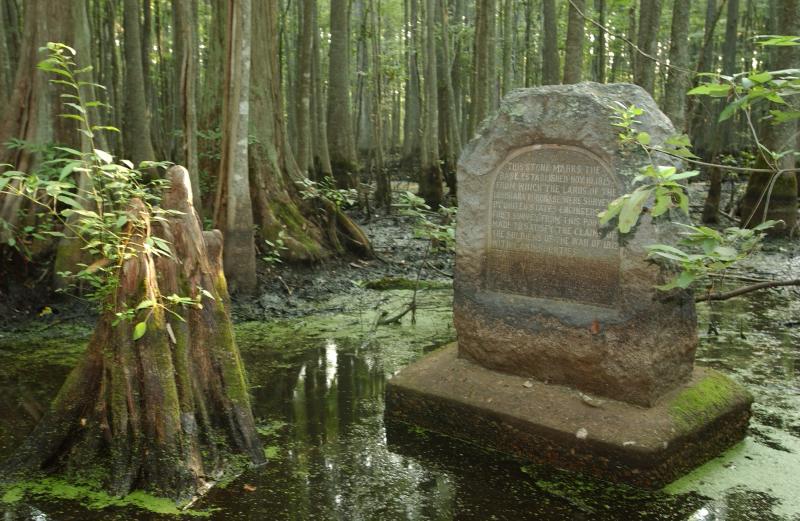
Historic Preservation
D.C. Boundary Stones
Daughters also note important lines and boundaries, such as the nation’s capital. In 1791, after years of controversy and debate over Washington, D.C.’s defining lines, President Washington issued a proclamation giving the exact boundaries of the “district for the permanent seat of government.” The first stone, at the southern corner, was ceremoniously laid at Jones’ Point on April 15, 1791. The last of the forty original stones defining the ten-mile-square area delineated by Andrew Ellicott (advisor to explorer Meriwether Lewis and most noted surveyor of his time) and his technical assistant, Benjamin Banneker (also a noted astronomer, mathematician and urban planner considered by many to be the first African American scientist) were laid in 1792. All of the stones bear the inscription “Jurisdiction of the United States” on the side facing the district; the opposite sides bear the inscriptions of either “Virginia” or “Maryland,” as appropriate to the state that ceded the land. For over a century, many of the stones languished, forgotten or lost in the mushrooming growth of the Capital City. On April 7, 1915, the District of Columbia Society adopted the reclaiming of the boundary stones as their project for the year. It was a permanent adoption. Over the years they have located and cataloged the original stones, improving the sites where possible and noting exact locations. They continue to preserve the historical monuments and create public awareness of their importance. In this July 11, 1916, photo, the Columbia Chapter and their guests—decked in their Sunday best despite the heat of the Washington summer—gather to commemorate the Northwest #4 stone. Chaplain General Mary Lockwood, festive in red, white and blue stripes, joined them for the celebration. Photo courtesy of DC DAR
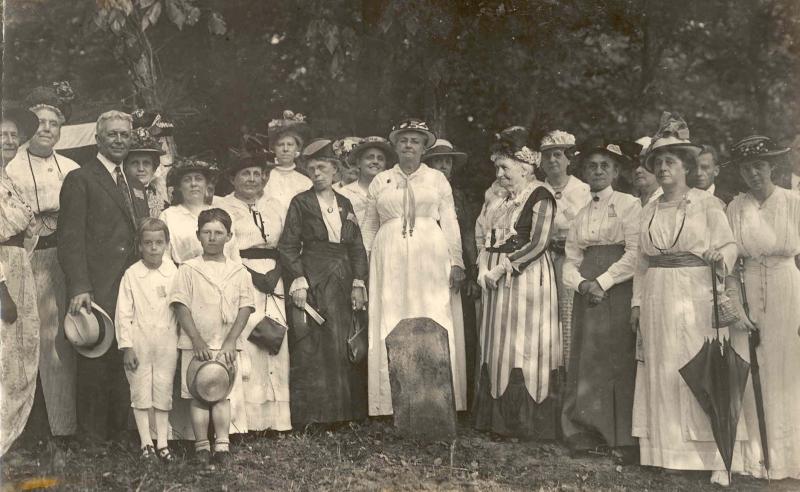
Historic Preservation
USS Maine
In 1915, the Lady Stirling Chapter in Seattle, Washington, unveiled a boulder and plaque placed in memory of the sinking of the USS Maine, the incident that would launch the Spanish-American War in 1898.
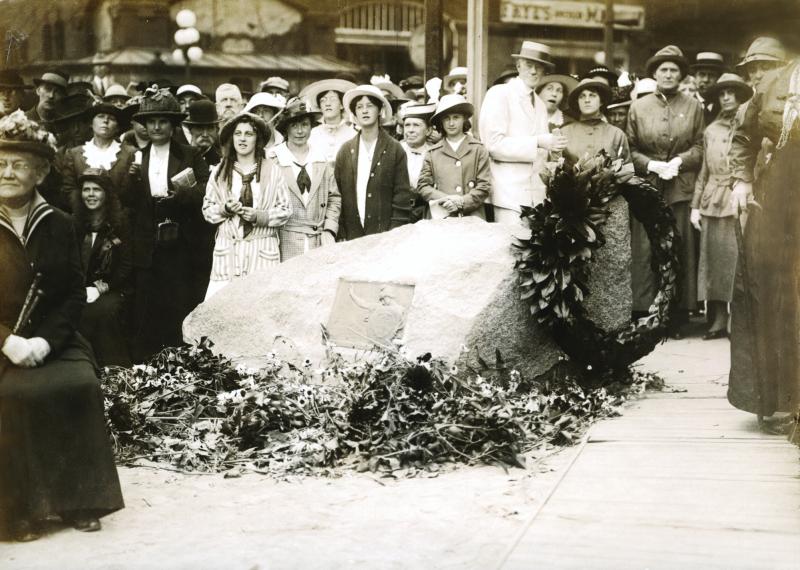
Historic Preservation
Old Belfry on Belfry Hill in Lexington, Massachusetts
In 1910, the Lexington Chapter dedicated a plaque on the original site of the Old Belfry on Belfry Hill in Lexington, Massachusetts. From there the bell summoned people to worship, warned them of danger, tolled on their deaths, and sounded the alarm of April 19, 1775. In Lexington later that day would be fired the "shot heard round the world" that began the war for American Independence. The plaque was refurbished in 1999. That famous “shot heard round the world” was almost fired in Framingham instead of Lexington. British spies in Buckminster’s Tavern observed the Minutemen of Framingham drilling on the old training field, and their report back to General Thomas Gage would convince him to take a less direct route in his march to Worcester.
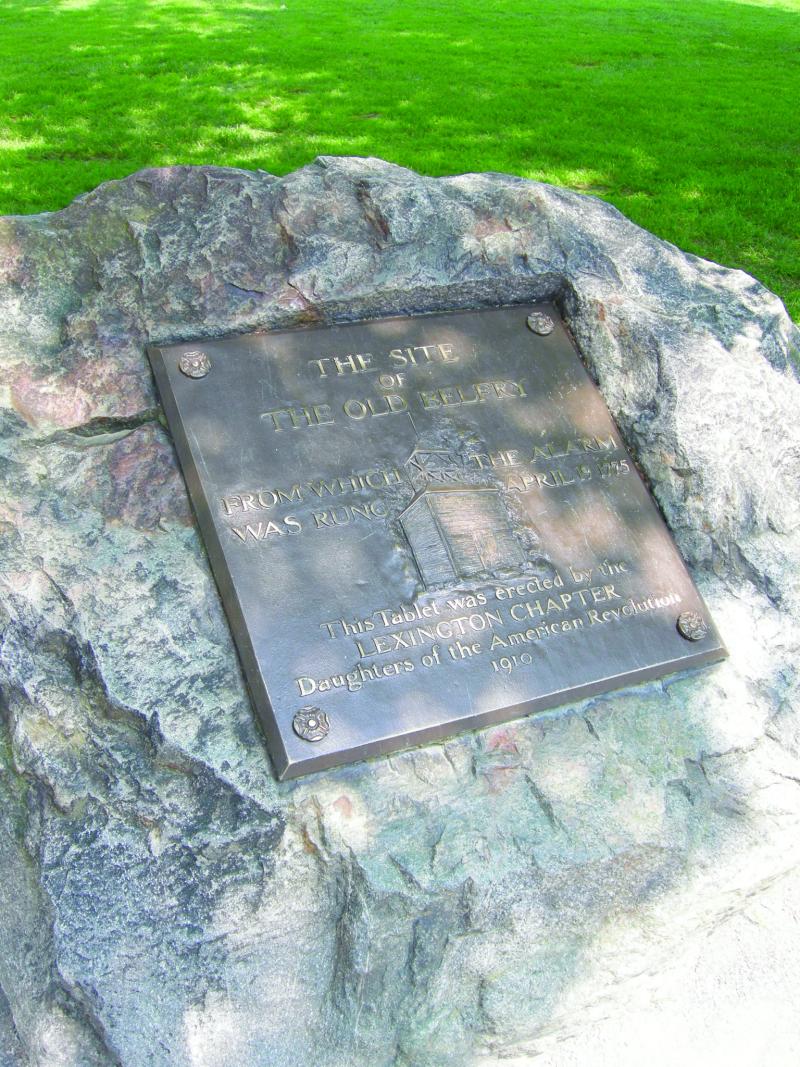
Historic Preservation
Travellers Rest
At Lolo, near Missoula, Montana, on October 9, 1925, members of the Bitter Root Chapter, Montana, unveiled a massive stone and plaque marking the location of a centuries old Native American campsite used by Meriwether Lewis and William Clark in 1805 and 1806. Other guests that day included Montana State Regent Mary Adelia Kelly Caldwell (second from left) and Anne Margaret Long (second from right), Vice President General. The explorers named the nearby creek “Travellers Rest,” the name repeated on the plaque. The DAR plaque also listed every single member of the expedition, including “Sacajawea” and her infant Baptiste, born on the trail. In digs as recent as 2002, archaeologists found physical evidence of the Corps of Discovery’s encampment, marking the site as one of the few in the nation with physical confirmation of the expedition’s sojourn at the site.
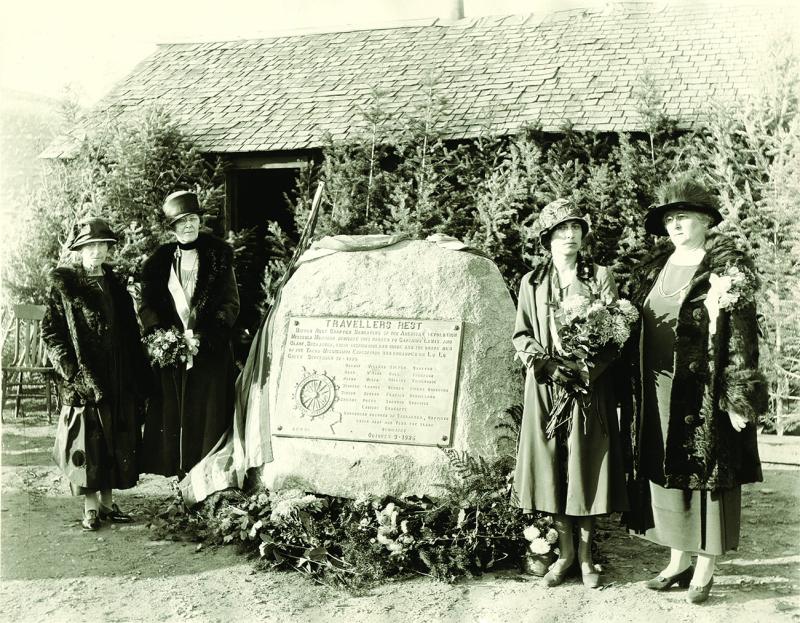
Historic Preservation
Madonna of the Trail
Inspired by the statue of Sacajawea erected in Portland, Oregon, DAR national committee chairman Arline B. Nichols Moss worked for five months with her son John Moss Jr., an artist and architect, to develop designs for the Madonna of the Trail monument. In 1927, at the recommendation of the stone manufacturing company who would produce the statues, she presented her ideas to architectural sculptor August Leimbach of St. Louis, even though he had not entered the competition for the design. Within three days, he had created a model and shown it to Arline Moss, who was departing immediately for a DAR meeting in Washington. Within days, she wired back that he was awarded the contract. The design features a pioneer woman of heroic proportions clasping her baby with her left arm while clutching a rifle with her right. Her young son clings to her skirts. Her face captures the beauty of a mother, strong in character but also gentle. Her roughshod boot strides forward on a path toward progress, crushing a thistle symbolizing the obstacles she would overcome. Arline Moss and August Liembach are pictured here circa 1928 putting the finishing touches on one of the Madonnas.
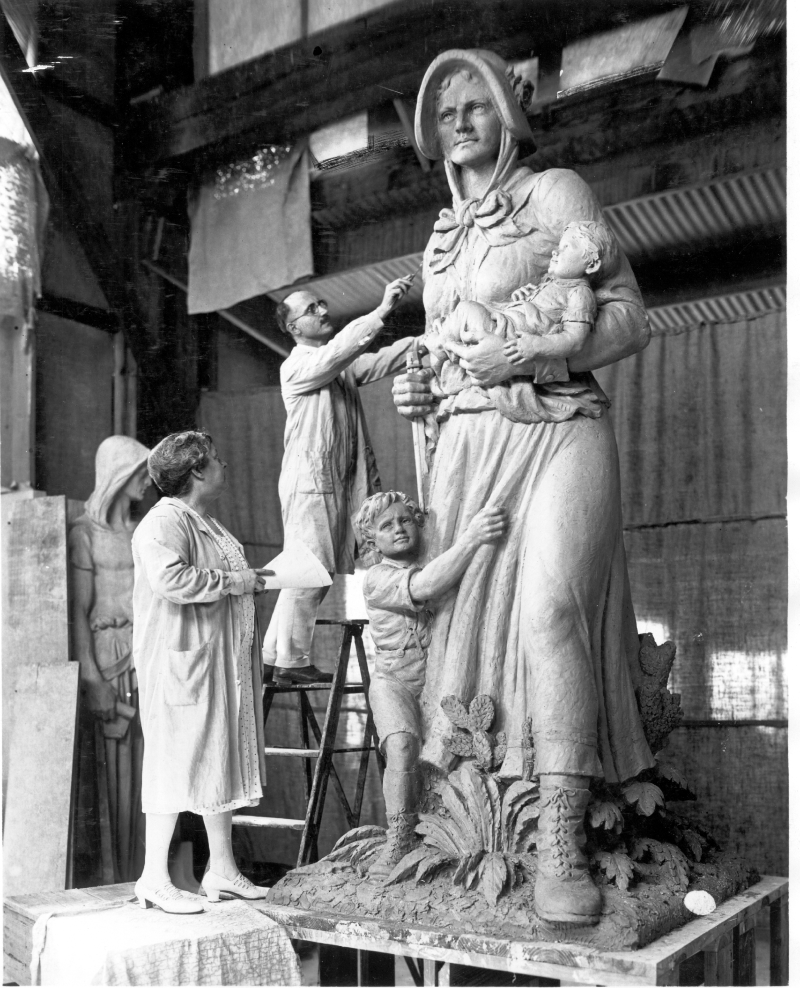
Historic Preservation
Madonna of the Trail
Participants at the Washington County, Pennsylvania, Madonna of the Trail dedication bundled up for the event held on a cold, blustery day, December 8, 1928. Honored guests included NSDAR President General Grace Brousseau, pictured at center holding the large bouquet. The winter temperature was not as cold as the chilly reception the monument had received a few months earlier in Pennsylvania, when the original plan called for this statue to be placed on the grounds of the Washington County Courthouse. The Pennsylvania State Art Commission ruled in September that the statue could not be erected on public property because “the figure submitted has not sufficient artistic merit to justify its erection . . ..” The Nemacolin Country Club quickly and most generously donated a piece of its property on Route 40, the National Road, so that the Madonna of the Trail statue could remain in Washington County. Not to be undone, the Daughters deemed the more visible location a better one than the original site at the local courthouse.
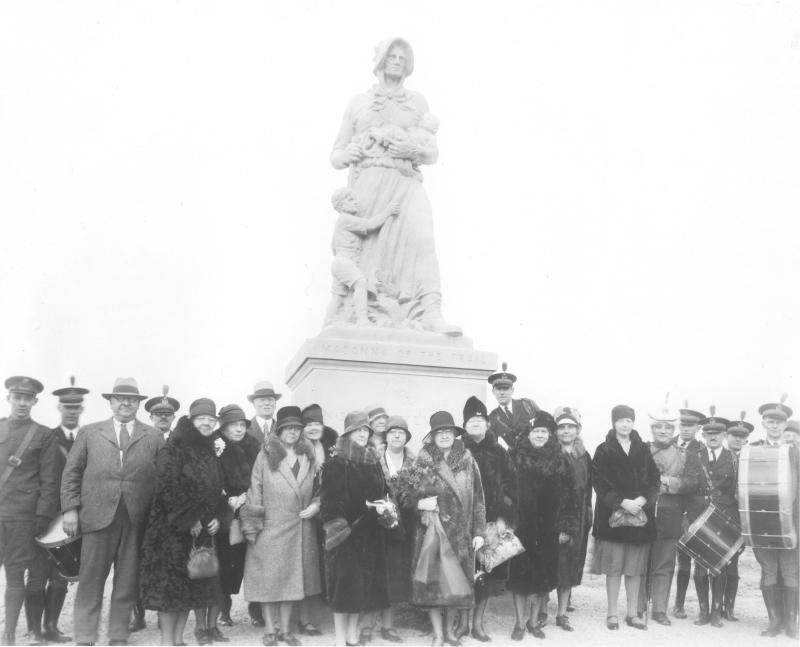
Historic Preservation
DAR State Forests
The Texas DAR still owns its very own forest, the DAR State Forest in the deep Piney Woods area of Southeastern Texas. In 1928, Texas Daughter Ida Caldwell McFaddin of Beaumont donated one hundred acres of forestland in east Texas. Subsequently, the State Society purchased fifty adjoining acres, increasing their forest by half its original size. Dedicated on October 31, 1929, it was rededicated October 31, 1995, as a part of the Texas DAR Centennial Celebration. Photo by Marie T. Crossley courtesy of Texas State DAR
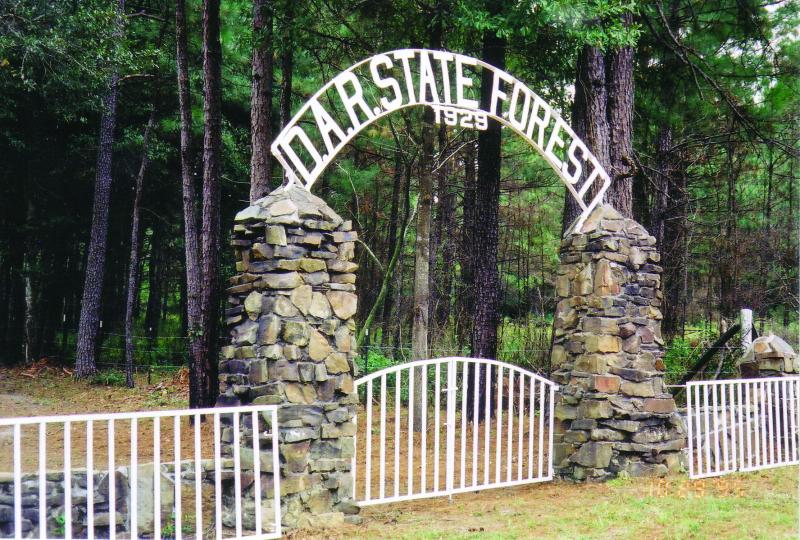
Historic Preservation
DAR State Forests
The DAR State Forest in Goshen, Massachusetts, attracts as many as 68,000 people a year. This spectacular state forest was established in 1929 when the Massachusetts State Society donated 1,020 acres to the state. A temple of timber now surrounds the boulder and marker placed in 1929 commemorating the forest’s creation. Since then they’ve acquired and donated another 750 acres to the preserve, including the Upper and Lower Highland Lakes. Listed by Reserve America in 2004 as one of America’s top one hundred family campgrounds, the forest is a popular recreational destination both summer and winter. As described by state forest supervisor Robert Kabat in a January 2006 story for the Associated Press, “They bought the land with the intention of handing it over to the state, and the state has turned it into a huge conservation and recreation area.” Photo courtesy of Massachusetts State DAR
Historic Preservation
Valley Forge Bell Tower
Built entirely by funds raised by the DAR, the 114-foot Valley Forge Bell Tower holds one of the most unique carillons in the world, with fifty-eight bells and thousands of plaques and inscriptions to honor more than nine thousand veterans of several wars. The tower features fifteen stained glass windows, such as the one pictured in inset. Photos by Doug Gefvert, Washington Memorial National Carillonneur
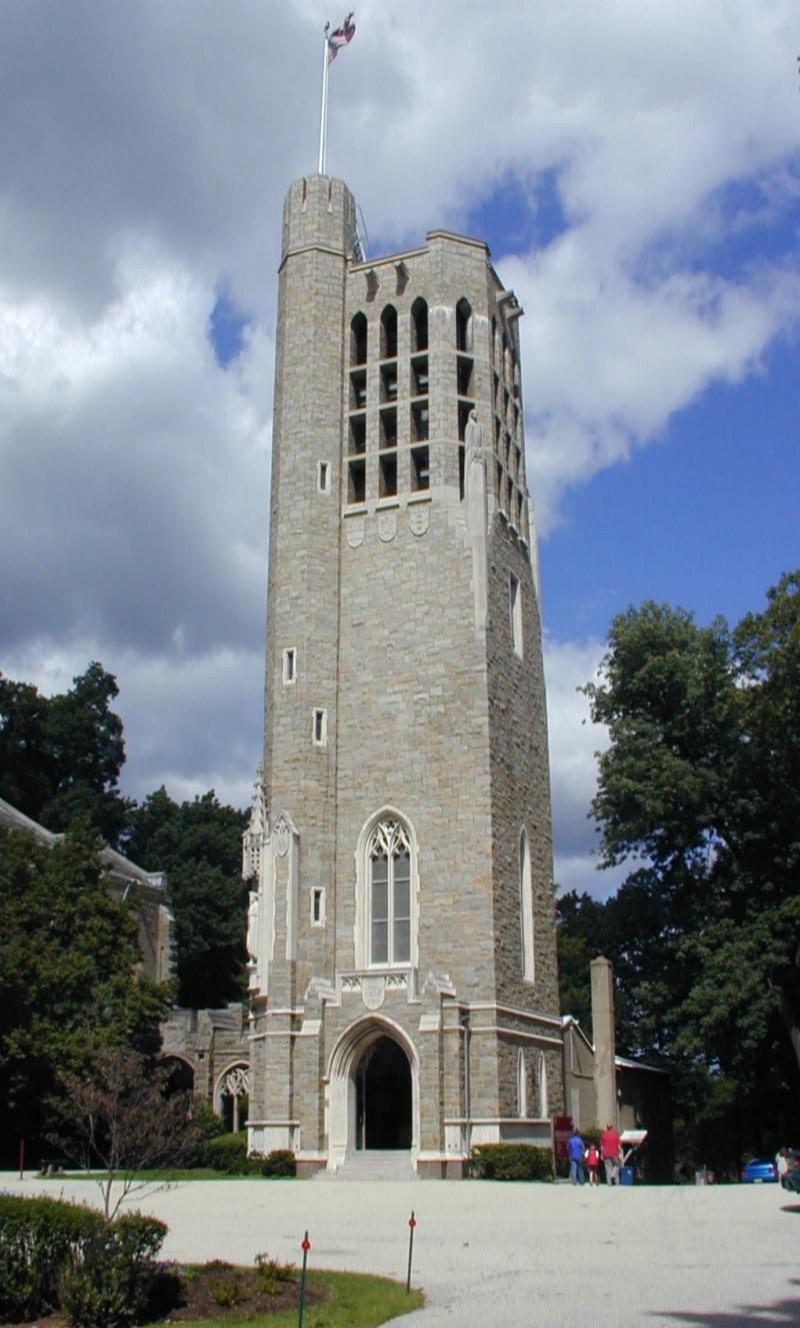
Historic Preservation
Ellis Island
This circa 1950 aerial photo of Ellis Island in its heyday shows the vast network of buildings that housed the thousands of immigrants who arrived through New York Harbor. The facilities later served as a Coast Guard Hospital before it was abandoned for decades. The DAR contributed thousands of dollars to the restoration of the buildings, some of which are now a popular tourist attraction managed by the National Park Service.
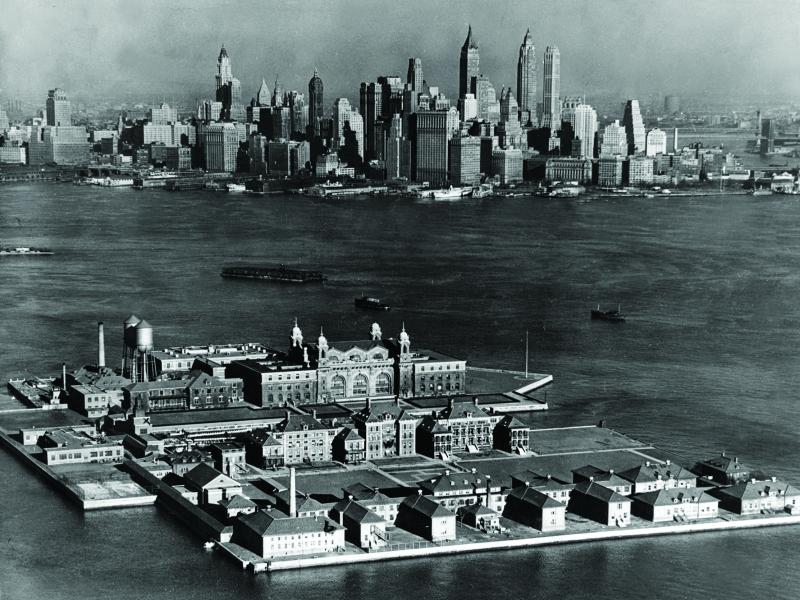
Historic Preservation
Ellis Island
In 1923, the Daughters began providing occupational therapy, such as needlecrafts, sewing, crochet and other activities for immigrant detainees on Ellis Island as a means of easing some of the tension while also providing meaningful and productive work. In this undated photo, a young boy learns how to use a sewing machine during a work therapy session. Photo from Press Association, Inc.
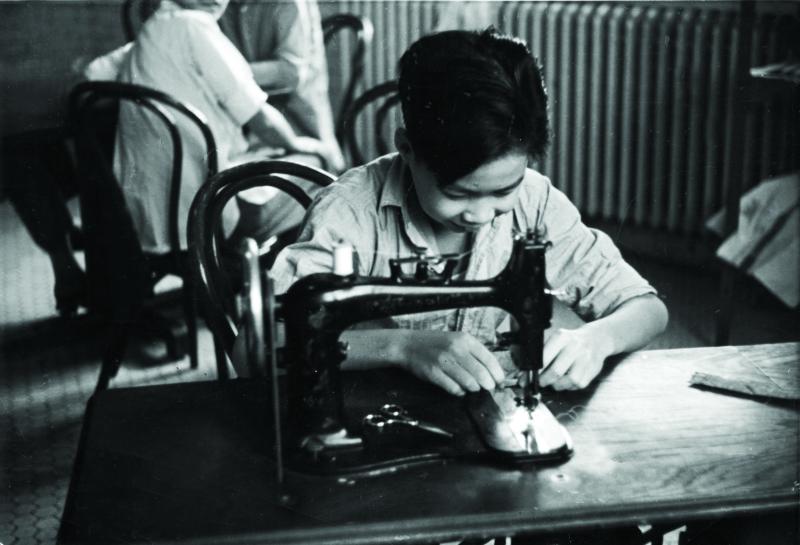
Historic Preservation
Ellis Island
As the flow of immigrants decreased, the federal government asked the Daughters to once again extend their service, this time to include occupational work with Merchant Marines, U.S. Coast Guard members, and lighthouse keepers treated at the hospital on Ellis Island. Some received tutoring from the staff paid by the Daughters in such areas as math and other subjects that could help them re-enter the workforce. Others became quite skilled in fabric weaving, knitting, painting, leather tooling, woodworking, and other handwork.
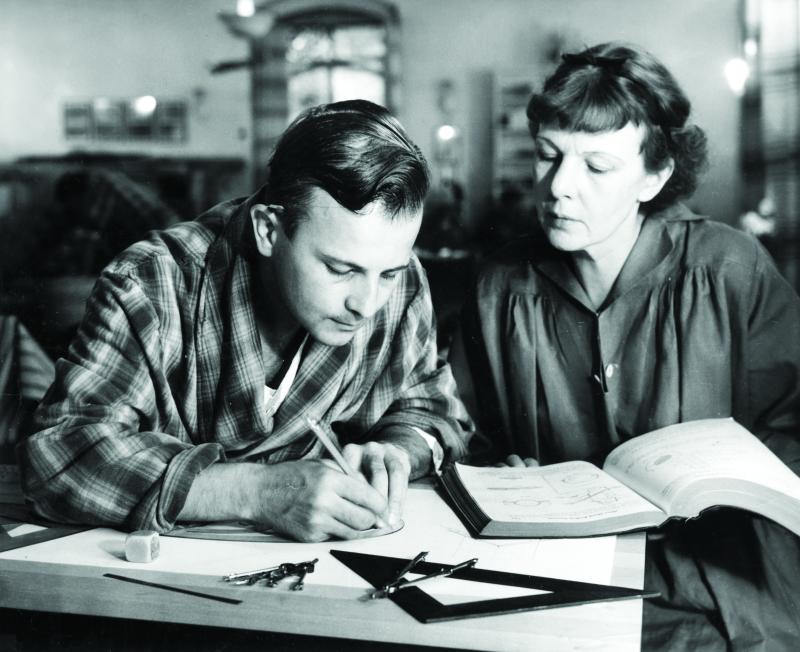
Historic Preservation
Prison Ship Martyrs' Monument
Beginning in 1896, the Society spearheaded, through its newly formed Fort Greene Chapter in Brooklyn, New York, an effort to raise more than $200,000 for a permanent monument to the thousands of prisoners who died aboard the British prison ships moored in Wallabout Bay during the American Revolution. The British held thousands of captives on eleven prison ships anchored in the East River, including the most notorious Jersey. As many as 11,500 men and women, representing all thirteen colonies and at least that many nationalities, died of overcrowding, contaminated water, starvation, and disease aboard the ships, and their bodies were hastily buried along the shore by their fellow prisoners. In 1808, the remains of the prison ship martyrs were buried in a tomb near the Brooklyn Navy Yard, but with no marker of any consequence. The 149-foot Prison Ship Martyrs Monument, unveiled at Fort Greene Park in Brooklyn on November 14, 1908, at last marked dignity the final resting place of the prisoners, as depicted on this program for the event. Program cover courtesy of New York Historical Society
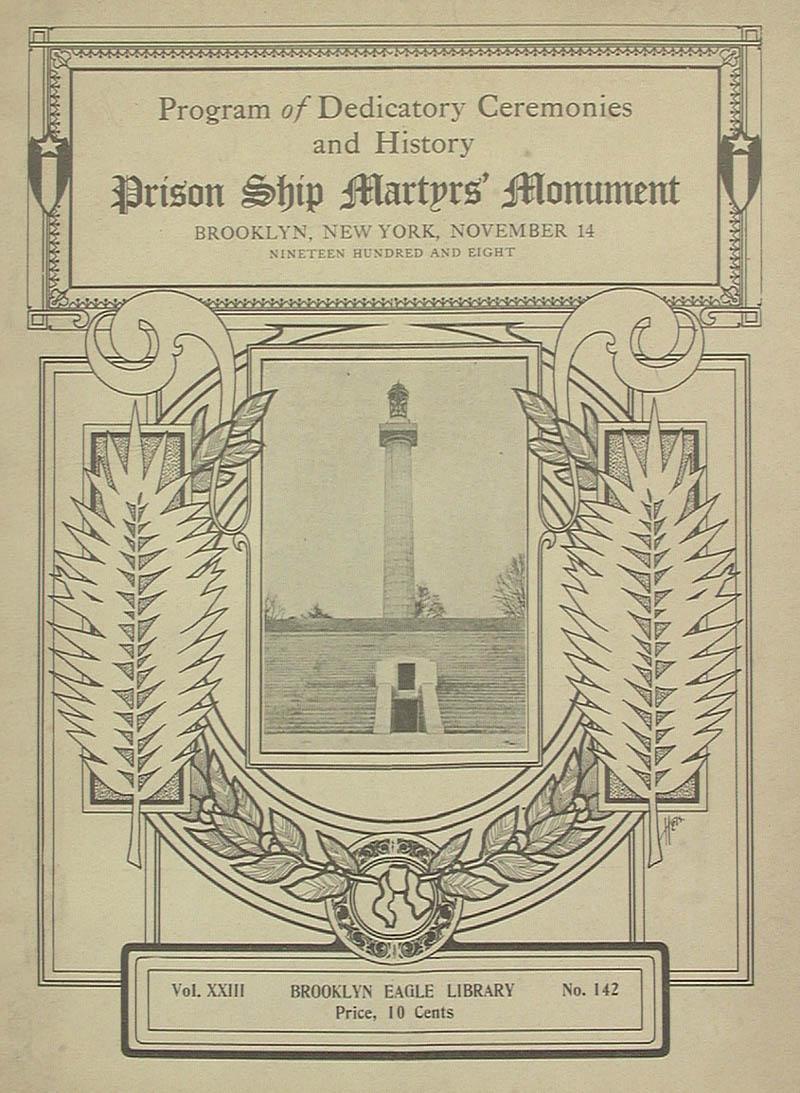
Historic Preservation
Independence Hall
In 1972, as an early bicentennial birthday gift, the DAR funded the complete furnishing of both the Governor’s Council Chamber and the Committee of the Assembly’s Room on the second floor of Independence Hall in Philadelphia. Following the ribbon cutting July 4, 1972, by President General Eleanor W. Spicer and other dignitaries, some 26,023 visitors viewed the rooms, which were re-opened for the first time in twenty-two years.
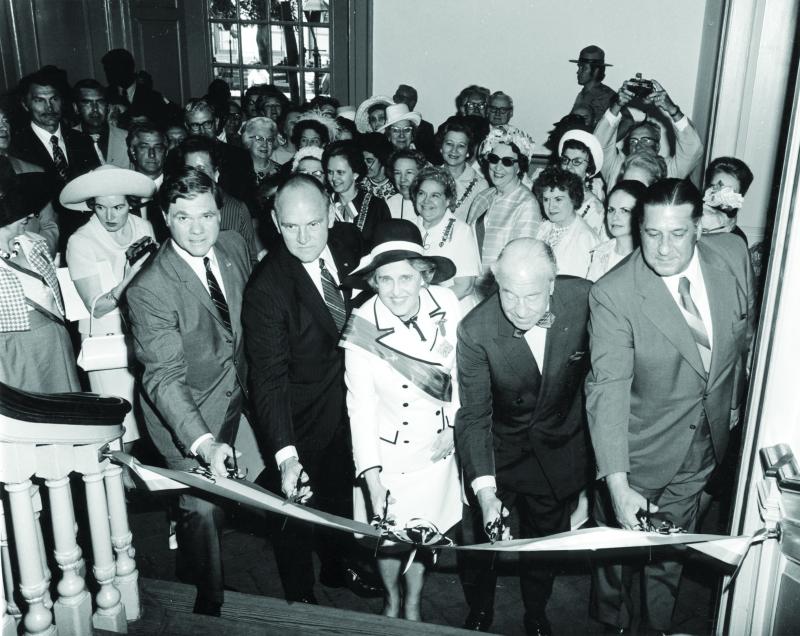
Historic Preservation
British Custom House
Unfortunately the seminal battle of the Revolution would take a terrible toll on the city of Yorktown, Virginia. Few buildings would survive the bombardment of the town by American and French forces in 1781 that drove British General Lord Cornwallis to surrender his army in the Battle of Yorktown. Ironically, one of the buildings that did withstand the assault was the British Custom House (pictured here), which dates from approximately 1720 and occupies a unique place in American history, for it was the storehouse and office of Richard Ambler, the first officially designated collector of customs for the British Crown in Yorktown, at the time one of the largest and busiest ports on the East Coast. Strategically located on Main Street, just a block away from the once-busy waterfront, the Custom House survived again as the Civil War raged through the town during McClellan's Peninsula Campaign in 1862. Although it would undergo several modifications, its character remains and today it is safeguarded by the stewardship of the Comte de Grasse Chapter of Yorktown, which acquired the property in 1924 and opens it free to the public for tours. Photo by Mary Ann Philyaw
Historic Preservation
Captain Molly
In this photo taken March 16, 1926, New York State Society Historian Amelia Campbell Parker (second from right), who led the search to determine Captain Molly’s true identity, and New York State Regent Mrs. Charles White Nash, accompanied by West Point officers, Captain George S. Andrew (left) and Lieutenant W. R. Fleming, pall bearers, watch over Margaret Corbin’s remains, which had just been reverently placed in the silk-lined casket and wrapped in the U.S. flag. The remains of the cedar stump that helped to verify the site as her original burial place can be seen at the head of the grave.
Margaret Corbin (Captain Molly) fought along side her husband during the American Revolution and when he was killed she manned his cannon like he had taught her. The New York State Organization gave her a proper grave in the cemetery besude the West Point cadet chapel and placed a granite monument that describes her heroic service.
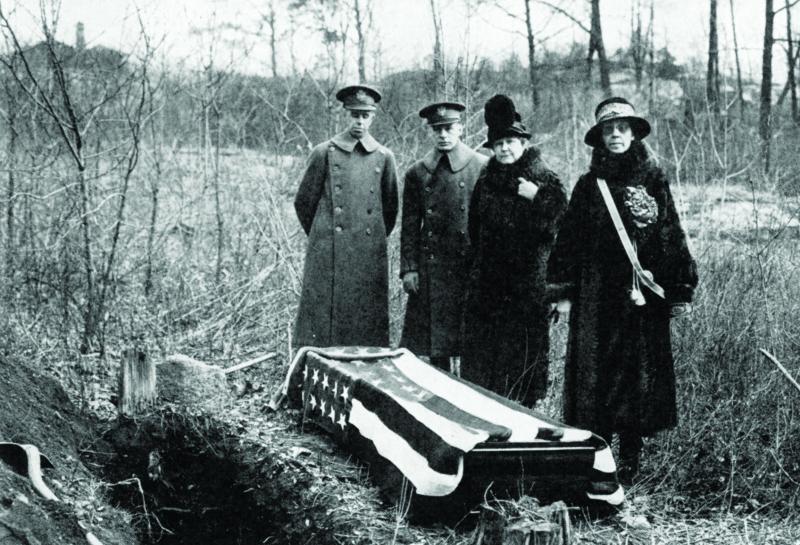
Historic Preservation
Sibley House
From 1910 until 1998, the Minnesota DAR owned and preserved the Sibley House, built in Mendota in 1835 by Henry H. Sibley, an agent in the lucrative fur industry. When Alexander Ramsey arrived in May 1849 to assume his duties as the first governor of the Minnesota Territory, he and his family were guests at the Sibley House where, on June 1, Ramsey issued the proclamation declaring the territory officially opened. The first laws of Minnesota were passed in the Sibley House and the first territorial legislature met here as well as the first territorial court. Reported to be the first stone house built in the territory, it is now owned by the Minnesota Historical Society. Minnesota Historical Society
Historic Preservation
North Platte, Nebraska Cabin and Schoolhouse
The last log cabin and first schoolhouse in North Platte, Nebraska, pictured here in an early photo, was about to be destroyed when the Sioux Lookout Chapter saved the building in March 1923. Constructed in 1867 by the Rowland family, it was still occupied by his descendants until 1922 when it was sold to the chapter, who paid to have it moved and restored. It is now part of the Lincoln County Historical Museum, where some of the pioneer relics displayed there have included items from the home of W. F. “Buffalo Bill” Cody and mementos of General George Armstrong Custer. Photo courtesy of the Lincoln County Historical Museum, North Platte, Nebraska
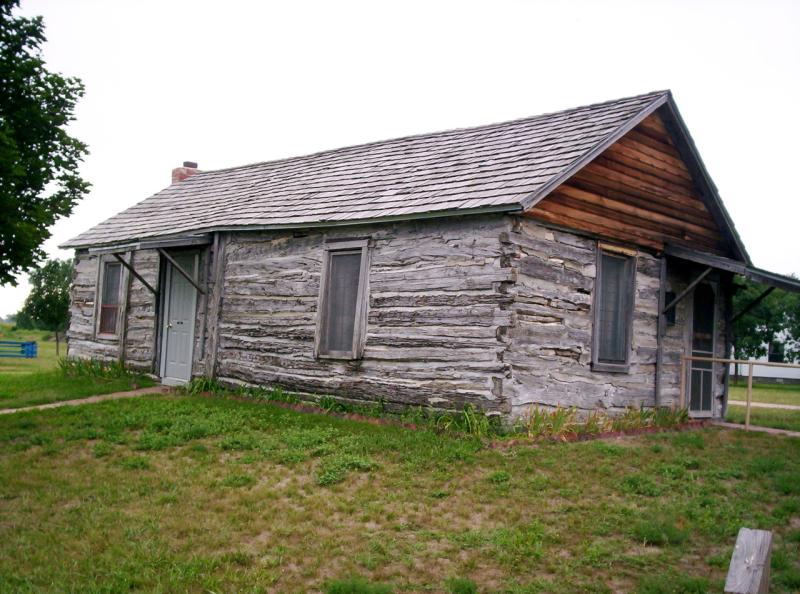
Historic Preservation
Rosalie Mansion
One of the most ambitious projects ever undertaken by a DAR State Society is the Rosalie Mansion in Natchez, Mississipi, now headquarters of the Mississippi State Society. The mansion, a magnificent example of the Federal Style of architecture, remains one of the state’s most prestigious antebellum mansions. The Mississippi State Society purchased the house in 1938 and has lovingly restored and maintained it ever since. It sits on a high bluff overlooking the Mississippi River, the site chosen by the French for the first settlement on the river in 1716, and was named "Fort Rosalie" in honor of the Duchess de Pontchartrain. Peter Little built the mansion circa 1820-1823, using the design of his brother-in-law, James S. Griffin. Rosalie is visited by thousands of tourists each year. Photo by Gordon Fikes
